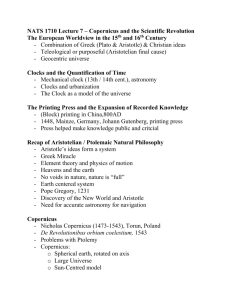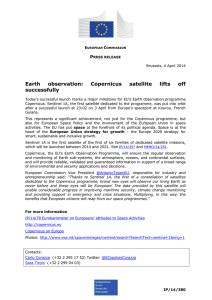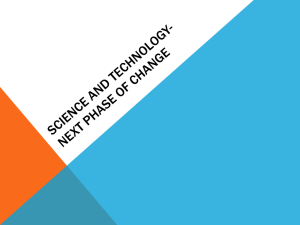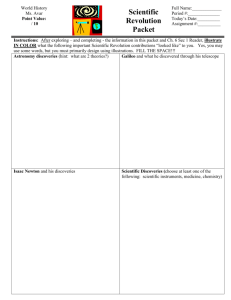English version
advertisement
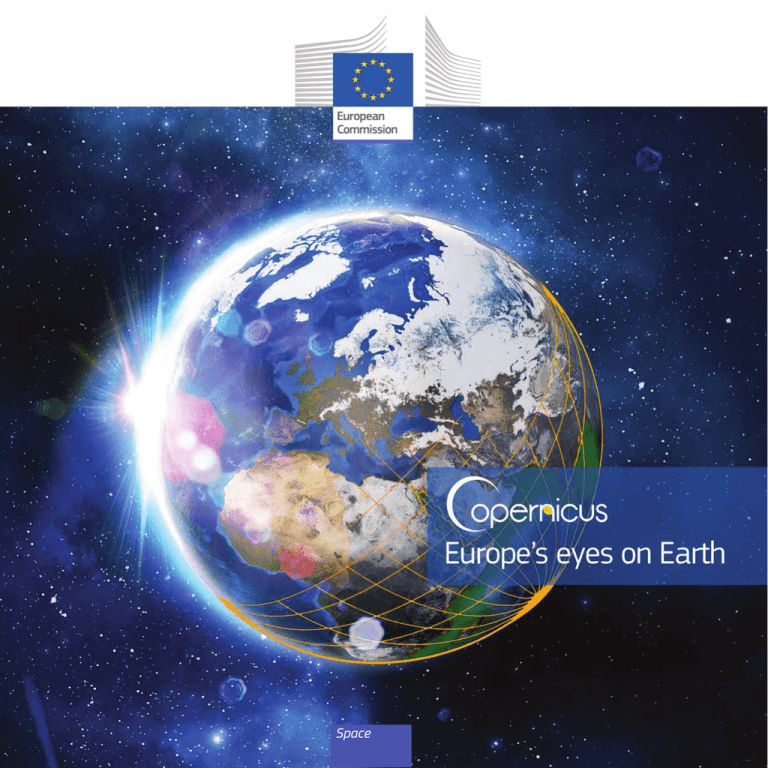
Space Copernicus Brochure European Commission Directorate-General for Communication Publications 1049 Brussels BELGIUM Europe Direct is a service to help you find answers to your questions about the European Union. Freephone number (*): 00 800 6 7 8 9 10 11 (*) The information given is free, as are most calls (though some operators, phone boxes or hotels may charge you). Cover illustration: © European Union, 2015 Internal pages: p. 2 © ESA p. 4 © ESA p. 6 © Thinkstock p. 9 © ESA p. 10 © ESA p. 12 © UN Photo/Evan Schneider p. 14 © Bec Thomas p. 16 © Shutterstock p. 18 © European Union p. 20 © Garry Knight More information on the European Union is available on the Internet (http://europa.eu). Luxembourg: Publications Office of the European Union, 2015 ISBN 978-92-79-45666-4 doi 10.2873/93104 © European Union, 2015 Reproduction is authorised provided the source is acknowledged. Printed in Belgium PRINTED ON ELEMENTAL CHLORINEFREE BLEACHED PAPER ECF COPERNICUS: EUROPE’S EYES ON EARTH “ Copernicus will deliver an unprecedented volume of free data, provide new operational services and foster new business opportunities and job creation.” Elżbieta Bieńkowska European Commissioner for Internal Market, Industry, Entrepreneurship and SMEs Since Nicolaus Copernicus formulated his heliocentric model of the universe, the frontiers of human knowledge have extended far beyond the boundaries of the solar system which it describes. Yet some of the biggest questions facing humanity still relate to our own planet, and our relationship with it. Too many of the Earth’s natural resources, on which we depend for our survival and development, are finite or, at best, limited. Yet our global population continues to grow, thus generating an ever-increasing demand for safe living space, fresh water, fertile land and clean air. • How can we best manage our consumption and utilisation of Earth’s natural resources and protect our environment for the benefit of future generations? • How will we guarantee the safety, security and quality of life of the millions of future new inhabitants of our cities and regions, and respond effectively to disasters and crises? • How can we improve our understanding of the causes and consequences of climate change, prepare adequate mitigation and adaptation measures? 2 To answer these and related questions, continuous awareness of the state and health of the environment is required, together with the capabilities to transform information into effective decisions. The Copernicus programme is a cornerstone of the European Union’s efforts to monitor the Earth and her many ecosystems, whilst ensuring that her citizens are prepared and protected in the face of crises and natural or man-made disasters. Building on the foundations of deeplyrooted scientific knowledge and on decades of EU investment in research and technological development, the Copernicus programme is exemplary of European strategic cooperation in space research and industrial development. The Copernicus programme places a world of insight about our planet at the disposal of citizens, public authorities and policy makers, scientists, entrepreneurs and businesses on a full, free and open basis. An inherently multidisciplinary and truly European enterprise, Copernicus brings together communities from across the geoinformation and environmental scientific spectrum, and delivers operational services which range from Arctic sea ice monitoring to emergency response, through oil spill detection and monitoring of urban sprawl. Copernicus services support a broad range of environmental and security applications, including climate change monitoring, sustainable development, transport and mobility, regional and local planning, maritime surveillance, agriculture and health. By making the vast majority of its data, analyses, forecasts and maps freely available and accessible, Copernicus contributes towards the development of new innovative applications and services, tailored to the needs of specific groups of users, which touch on a variety of economic and cultural or recreational activities, from urban planning, sailing and insurance to archaeology. Copernicus marks the beginning of a new era in Earth Observation. Sentinel satellites are being launched, operational Copernicus services are available, and the first green shoots of the “Copernicus Economy” are starting to be seen in the form of value-added (“downstream”) applications (see page 22). Through this brochure, we invite you to learn about the many facets of the Copernicus programme: its actors and their roles, as well as its mechanisms, its success stories, and its benefits and applications for Europe and its citizens, with a special focus on six cross-cutting topics dealing with major societal goals. Copernicus services are based on information from a dedicated constellation of satellites, known as “Sentinels”, as well as tens of thirdparty satellites known as “contributing space missions”, complemented by “in situ” (meaning local or on-site) measurement data. 3 WHY COPERNICUS? Copernicus is the European Union’s revolutionary Earth Observation and Monitoring programme, looking at our planet and its environment for the ultimate benefit of all European citizens. Thanks to a variety of technologies, from satellites in space to measurement systems on the ground, in the sea and in the air, Copernicus delivers operational data and information services openly and freely in a wide range of application areas. ACHIEVING MAJOR SOCIETAL GOALS BRINGING TOGETHER EUROPEAN EFFORTS Society as a whole is facing numerous global threats, including climate change, a looming energy crisis, population growth, potential food shortages, and a higher frequency and intensity of natural and manmade disasters. Copernicus can facilitate the management of such threats and enable progress towards societal goals in areas such as renewable energy, food security, disaster risk reduction and climate change mitigation and adaptation. Copernicus builds on many years of European research and development and on existing European and national capacities, experience and know-how. For example, a number of short to medium term missions were put in place by the European Space Agency (ESA) in a research and development context. Moreover, several European countries independently conducted Earth Observation activities that remained fragmented and were both costly and difficult to maintain over time. Copernicus is the result of a long-term EU commitment to provide continuous, comparable, sustainable and high-quality information, and allows for economies of scale amongst the participating organisations. BY THE EUROPEAN UNION, FOR THE EUROPEAN CITIZENS As a civil European programme, Copernicus responds to the needs of its users and ultimately serves European citizens, both directly through its products and applications, and indirectly through its social, economic and environmental benefits. Copernicus contributes to the excellence of European industry in space – a highly strategic sector with strong growth potential. Earth Observation is just one of the activities where it is better to pool European citizens’ resources, and act at Union level rather than as single Member States. THE EU AS A STRONGER GLOBAL ACTOR As a global actor on the world stage, the EU requires independent information on how its policies and decisions impact and interact with other countries and regions in the rest of the world. Copernicus provides Europe with an autonomous capacity for Earth Observation, whilst simultaneously setting the stage for European participation in global initiatives1 both bilateral and multilateral2. The full, free and open data policy of the Copernicus programme fosters the role of “so¬ power” of the EU in the international arena. Copernicus data and information will support the EU’s position in international negotiations on climate, environment and biodiversity, thereby strengthening the European Union’s role in space. 1 2 4 Such as GEOSS – the Global Earth Observation System of Systems and CEOS – Committee on Earth Observation Satellites. Such as those already established, for example, with Africa in the context of the EU-Africa Strategy. A PUBLIC GOOD FOR GLOBAL BENEFIT The full, free and open data provided by Copernicus will support regional, national, European and international efforts to identify, respond and adapt to global phenomena, such as climate change, land management, atmospheric pollution, state of the seas, just to name a few. By supporting Europe’s responsibilities as a global actor involved in peacekeeping, emergency response and humanitarian aid, Copernicus brings benefits to EU citizens as well as to the international community. business. In addition to supporting environmental protection and the security of citizens, Copernicus will stimulate European enterprise to explore new growth, business opportunities and foster job creation. The expected positive impact of Copernicus on the European economy in terms of financial benefit and job-creation has been analysed in three independent studies4. FOSTERING RESEARCH AND INNOVATION Copernicus supports cutting-edge research and development by supplying scientists and researchers with regularly-updated information as well as operational products and services. Copernicus creates opportunities for innovation in the development of new, value-added application and services (known as the “downstream” sector) thanks to the full, free and open data policy. Copernicus thus represents a major contribution to the on-going development of Europe’s scientific and industrial capabilities. CONTRIBUTING TO THE ECONOMY According to an OECD report “the space sector plays an increasingly pivotal role in the functioning of modern societies and their economic development as the use of satellite technology gives rise to new applications, uses and markets.” The OECD estimates that the consumer services or downstream activities account for 58%3 of the “global space economy” and include actors, which are not part of the space community, but rely on satellite data and signals for their 3 http://www.oecd.org/sti/the-space-economy-at-a-glance-2014-9789264217294-en.htm. 4 SpaceTec Partners (2013) Injection paper: Preliminary Note in Preparation for Copernicus Impact Assessment; SpaceTec Partners (2012) Assessing the Economic Value of Copernicus: “European Earth Observation and Copernicus Downstream Services Market Study»; Booz & Co (2011) Cost-Benefit Analysis for GMES. 5 ACTORS, ROLES AND MECHANISMS WHO IS BEHIND COPERNICUS? DATA FROM SPACE DATA ON THE GROUND, IN THE SEA, IN THE AIR The Copernicus programme is supported by a family of dedicated, EU-owned satellites – the Sentinels -, specifically designed to meet the needs of the Copernicus services and their users. Since the launch of the first of these – Sentinel-1A – in 2014, the Union set in motion a process to place a constellation of more than a dozen satellites in orbit over the course of the next ten years. The Sentinels fulfil the need for a consistent and independent source of high-quality data for the Copernicus services. Copernicus also draws on a large number of in situ (meaning on-site or local) measurement systems put at the disposal of the programme by the EU Member States. These include sensors placed on the banks of rivers, carried through the air by weather balloons, pulled through the sea by ships, or floating in the ocean. In situ data are used to calibrate, verify and supplement the information provided by satellites, which is essential in order to deliver reliable and consistent data over time. Copernicus also builds on existing space infrastructure: satellites operated by the European Space Agency (ESA), the European Organisation for the Exploitation of Meteorological Satellites (EUMETSAT), the EU Member States and other third countries and commercial providers. These are known as contributing missions, and have provided satellite data for the programme since its inception. They will continue to do so, particularly where very high resolution data are required, such as in Emergency or Security applications. The Copernicus Services transform this wealth of satellite and in situ data into value-added information by processing and analysing the data, integrating it with other sources and validating the results. Datasets stretching back for years and decades are made comparable and searchable, thus ensuring the monitoring of changes; patterns are examined and used to create better forecasts, for example, of the ocean and the atmosphere. Maps are created from imagery, features and anomalies are identified and statistical information is extracted. COPERNICUS SERVICES: TURNING DATA INTO INFORMATION Land Monitoring These value-adding activities are streamlined through six thematic streams of Copernicus services: Marine Monitoring Land Atmosphere Monitoring Atmosphere Monitoring; Marine Land Emergency Monitoring Management Marine Environment Monitoring; Marine Land Atmosphere Security Monitoring Monitoring Land Monitoring; Marine Atmosphere Emergency Climate Monitoring Monitoring Management Change Climate Change; Atmosphere Emergency Security Monitoring Management Emergency Management; Emergency Security Climate Management Change Security. Security Climate Change Well-defined user communities have evolved in these areas, but as Climate Changethe following pages will show, many other sectors benefit directly and indirectly from Copernicus services. 6 Copernicus represents a genuinely European collaborative endeavour. As a publicly-funded European Union programme, Copernicus is first and foremost the property of all European citizens, who remain its ultimate owners and beneficiaries. In partnership with the EU Member States, the European Commission oversees and coordinates the programme and ensures that it remains user-driven. The European Commission is in charge of setting and developing the political vision of the Copernicus’s programme and of putting in place the elements which allow the smooth and proper functioning of the system. Together with the European Parliament and Council, the European Commission is responsible for the longterm financial commitment, ensuring the basis for the programme’s sustainability. EU and ESA Member States contribute to Copernicus in several ways: through development of satellites in ESA, the provision of data from nationally-owned space infrastructures, the supply of data from nonspace (in situ) data sources, or by participating, under the coordination of the European Commission, in the “collaborative ground segments”, in which Member States can have direct access to Sentinel data by funding and developing their own ground segment facilities (receiving stations, processing and archiving centres, country-specific applications, etc.). (notably the Joint Research Centre - JRC) or is entrusted to European entities and agencies with the appropriate expertise. The European agencies involved are the European Environment Agency (EEA), the European Agency for the Management of Operational Cooperation at the External Borders of the Member States of the European Union (FRONTEX), the European Maritime Safety Agency (EMSA) or the European Satellite Centre (SatCen). Other competent organisations involved are the European Centre for Medium-Range Weather Forecasts (ECMWF) and Mercator Océan. The provision of data from in situ infrastructure is coordinated by the European Environment Agency (EEA). Programme Manager SPACE S E NTI NE L S MI S S I ONS OP E R ATE D BY C ONTR I B U TI NG MI S S I ONS The development of the space component, including the launch of the dedicated Sentinel satellites, has been delegated to ESA, which also acts as the overall systems architect of the Space Component and ensures its technical coordination. The operations of the Sentinels have been entrusted to ESA and to EUMETSAT, on the basis of their specific know-how. The Sentinels are owned by the European Union. SERVICES IN SITU TE C H NI C A L C OOR DI NATI ON BY IMPLEMENTED BY HOW DOES IT WORK? EU Member States COORD INAT ED BY EU Member States A constellation of actors The operational implementation of the programme, as overseen by the European Commission’s Directorate-General for Internal Market, Industry, Entrepreneurship and SMEs, is either performed directly by the competent services of the European Commission 7 OVERVIEW OF THE BENEFITS AND APPLICATIONS Copernicus enables an improved understanding of the Earth as an integrated system. European citizens, ranging from policy makers, researchers, commercial to private users, as well as the global scientific community can benefit in many ways from the information provided by the different Copernicus services. These are a few examples of the added value of Copernicus in our daily life (some of which are further developed in the following pages). AGRICULTURE DEVELOPMENT AND COOPERATION Regular assessment of crop areas; crop development monitoring at regional and global scales; food security assessment; harvest estimation; support to sustainable agricultural practices (e.g. estimated irrigation needs); Applications to monitor agriculture and food security, deforestation and desertification, or biodiversity in developing countries in collaboration with partner countries and international organisations (such as the African Union, United Nations institutions); CIVIL PROTECTION AND HUMANITARIAN AID Through the Emergency Response Coordination Centre: coordinated forecast and response to major disasters and humanitarian crises, accurate geographic information for population rescue, logistics, water supply infrastructures, demography, health facilities and environment for those areas affected by natural hazards or man-made disasters (see pages 12-13); ENERGY Support to the selection and management of renewable energy production sites through the provision of information on features including water reservoirs, precipitation and snow stored during winter, monitoring of critical assets like nuclear plants, or protection of vital infrastructure like power plants or pipelines; assessment of the efficient use of energy for industrial plants and buildings (see pages 10-11); HEALTH TRANSPORT AIR, LAND, WATER European air quality monitoring and global atmospheric composition, mapping of possible outbreaks of epidemics or diseases, preparedness planning for public health emergencies (see pages 14-15); Monitoring of shipping routes or oil spill monitoring, control of maritime traffic for safety and surveillance purposes; aviation safety and support to air traffic when extreme situations occur; geo-hazard and environmental risk assessment in critical areas for land transport (see pages 20-21); INSURANCE Applications in support of risk modelling, hazard and damage assessment and claims management; BLUE ECONOMY Monitoring the marine environment to enhance marine knowledge and thus support the sustainable development of the marine economy in various sectors such as offshore oil and gas or coastal and maritime tourism; TOURISM Monitoring of coastal zones, provision of critical indicators and indices for assessment and planning of seasonal tourism activities, such as snow cover, European bathing waters quality, contribution to the protection of natural and cultural heritage; SECURITY Support to external actions of the European Union, including peacekeeping operations, monitoring of European land and maritime borders and maritime surveillance at large, in support of a broad spectrum of communities; URBAN AND REGIONAL PLANNING At regional or city level, land use and land use change monitoring, detailed high resolution maps of EU main cities in support of urban planning to assure sustainable and balanced development (see pages 16-17). CLIMATE CHANGE Solid scientific evidence for the geophysical variables addressing climate change, climate indicators (e.g. temperature increase, sea level rise, ice sheet melting, warming of the oceans), climate indices (e.g. based on records of temperature, precipitation, drought events) (see pages 10-11); 8 ENVIRONMENT Monitoring of atmospheric composition, of snow and ice, and of biodiversity, assessment of water cycle parameters like soil moisture or water bodies, monitoring of forests and coastal zones, regular monitoring of soil and assessment of sealed surfaces, forest damage assessment and desertification monitoring (see pages 18-19); monitoring of the oceans and European seas, of the marine and coastal environment, and of marine water quality; observations like ocean color and sea level; 9 Marine Monitoring Security Land Monitoring CLIMATE AND ENERGY Atmosphere Monitoring Marine Monitoring Land Monitoring Emergency Management Atmosphere Monitoring Marine Monitoring Climate Change The temperature – and therefore, the health – of our planet is the result of a delicate balance of phenomena, such as the movement of ocean currents, the transformation of carbon as it travels between land, sea and air, and the amount of sunlight Atmosphere Emergency Security absorbed or reflected by the Earth’s surface. But the balance can easily be disrupted, as we are realising with increasing concern. Management Monitoring The international community agrees that human reliance on burning fossil fuels for energy is considered to be one of the causes of global climate change, and on the other hand, we face a looming energy crisis as the threat of peak oil approaches. Climate Change The European Union has made action on climate and energy a clear priority, and has committed to ensuring that renewable sources make up 20% of total EU energy consumption by 2020, and 27% by 20305. Copernicus supports these priorities by monitoring our changing climate, helping us to prepare for and respond to its effects (adaptation), and facilitating the effective use of renewable resources (mitigation). CLIMATE AND WEATHER MONITORING, FORECASTING, PROJECTIONS AND PREDICTION Copernicus improves our capabilities to monitor, forecast and make projections about the changing climate, by increasing the number and sources of raw data at our disposal, producing services based on integration, modelling and analysis of these data, and by coordinating the production of certified climate information from multiple sources. Security Emergency Management RENEWABLE ENERGY AND BETTER MANAGEMENT OF EXISTING RESOURCES Climate the Change power Security Harnessing of natural resources like sunlight, water, wind and waves offers a smart solution to the dual challenge of climate and energy, simultaneously decreasing our reliance on fossil fuels whilst Climate Change reducing our contribution to the causes of global warming. Copernicus can help us to plan and manage our efforts in order to make the most of the variability inherent to these phenomena. MITIGATION AND ADAPTATION Knowing that our natural environment is changing allows us to effectively develop strategies for both mitigation (attempting to minimise the magnitude of the effects of climate change, for example, by reducing greenhouse gas emissions) and adaptation (reducing our vulnerability to the effects of the changing climate), which Copernicus supports through its dedicated Climate Change Monitoring Service. MONITORING THE ICE EXTENT IN THE ARCTIC Because ice reflects sunlight (whereas oceans absorb it), the Arctic ice cap is one of the Earth’s natural defence mechanisms, helping to regulate the temperature of the oceans and the atmosphere. An increase in temperature in this region could cause a positive feedback loop (melting ice causing a further increase in temperature, etc.) and this has the potential to influence climate patterns all over the world. Ice extent in the Arctic has been declining at an alarming rate in recent years. Copernicus ice monitoring services keep an eye on the poles and give us insight into the rate at which the ice extent is changing over time. Jan 2012 April 2012 July 2012 Sep 2012 These images show a monthly picture of Arctic sea ice for several months in 2012 the year of the current record low of summer sea ice extent (Credits: PolarView/University of Bremen). SUPPORTING THE DEVELOPMENT OF RENEWABLE ENERGY SOURCES Solar: The Copernicus Atmosphere Monitoring service monitors and forecasts the state of the atmosphere, and this includes the clouds and atmospheric particles (aerosols) which influence the amount of solar radiation reaching the Earth’s surface. Wind (on- and off-shore): Optimal wind energy exploitation on land depends on several factors, including the profile of the terrain and the amount and strength of the wind in an average year. Copernicus data enables the development of tailored, value-added (“downstream”) services like the wind power map of Belgium shown on the right. This map can help wind farm developers to select the most appropriate site for new installations, and can be used to predict their output. Through the Copernicus Marine Environment Monitoring Service, off-shore wind energy potential can also be assessed and forecasted. This map shows the wind power density (measured in Watts per m2) over the surface of Belgium, at 100 m above ground level (Credits: 3E). Hydroelectric: By monitoring and forecasting snow, ice and river runoff, Copernicus can support the planning of hydroelectric dam placement. Waves and currents: Copernicus supports the development of services for wave and current forecasting through its Marine Environment Monitoring Service. UNDERSTANDING THE EFFECTS OF GLOBAL SEA LEVEL RISE Even a small increase in the global sea level could have major consequences for the Earth’s populations, particularly for those situated on coastal regions. Monitoring of ocean level changes is necessary for planning coastal management and adaptation measures such as coastal defence systems, improved building codes and restrictions. Copernicus delivers continuous and reliable information about the extent and effects of sea-level rise in low-lying coastal areas across the globe through its Marine Environment Monitoring Service. 5 10 http://www.consilium.europa.eu/uedocs/cms_data/docs/pressdata/en/ec/145397.pdf. The image shows the global ocean sea surface height (Credits: Copernicus Marine Environment Monitoring Service, courtesy of Mercator Océan). 11 Atmosphere Monitoring EMERGENCY RESPONSE AND CRISIS MANAGEMENT Emergency Management Emergency Management Security Security Climate Change Climate Change Natural disasters affect thousands of people every year in Europe and in the rest of the world. European authorities are connected to a global community of response, aid and support organisations. Initiatives such as the European Civil Protection Mechanism and the International Charter on Space and Major Disasters provide a platform for collaboration and support across borders in times of crises. Copernicus provides global and operational European services for early warning, emergency response and crisis management, reinforcing Europe’s position as a responsible global actor. MAPPING POPULATION VULNERABILITY Bolivia is regularly affected by floods during its annual rainy season between October and April. Wetlands and large rivers pose a risk to the local population and their livelihoods, due to the fact that houses were built near floodprone areas. At the request of local authorities and through the European Commission’s Directorate-General for Humanitarian Aid and Civil Protection, the Copernicus Risk & Recovery Mapping Service provided an assessment of the vulnerability of population, infrastructure and assets to flood risk in several areas of northern Bolivia. Forty-five maps were delivered, in total, and the example on the right is a population vulnerability map of Rio Mamore (pale red areas denote low vulnerability, whilst dark red shows highly vulnerable zones). Copernicus EMS map of Rio Mamore, Bolivia, providing an assessment of the vulnerability of the population to flooding (Credits: Copernicus Emergency Management Service). EARLY WARNING FOR FOREST FIRES AND FLOODS PREPAREDNESS, RISK REDUCTION AND RECOVERY ANTICIPATION AND EARLY WARNING BEFORE CRISES Knowing where vulnerable citizens and infrastructure are located enables measures to be taken to reduce the impact of a potential disaster. The Copernicus Risk & Recovery Mapping Service (a component of the Emergency Management Service) provides maps, combining hazard information with socio-economic data to support effective preparedness, prevention and disaster risk reduction activities. Other applications made possible by this service include post-disaster needs assessment, support to recovery planning and monitoring of reconstruction and rehabilitation programmes. Advanced fire risk and flood warning information from Copernicus supports authorities in Europe and beyond in proactively preparing for imminent crisis response. The Early Warning component of the Copernicus Emergency Management Service strengthens the preparedness of national Civil Protection agencies in anticipation of flood events and forest fires. BETTER INFORMED RESPONSES ON THE GROUND The Copernicus Emergency Management Rapid Mapping Service provides teams on the ground with maps of the area in the first hours following a crisis. First responders receive a map from within 3 hours of the satellite data arriving back at the ground station6 . These maps can guide the teams on the ground in organising the safe evacuation and sheltering of citizens affected by the crisis. 6 12 Emergency Management Rapid Mapping Services provide an early analysis product (First Available Map) within 3 hours of satellite data reception. The Copernicus Emergency Management Service includes the European Flood Awareness System (EFAS) which provides flood forecasts to national Civil Protection Agencies for all European rivers, and the extension of this service on a global scale is currently being tested (a pre-operational pilot service is available), with the launch of a robust worldwide operational system envisaged for 2017. Similarly, the Copernicus Emergency Management Service includes the European Forest Fire Information System (EFFIS) which provides fire danger forecasts up to 10 days in advance for the European, Middle East and North Africa regions. A prototype of the upgrade of this system, the Global Wildfire Information System (GWIS) is also available. EFAS warnings during Balkan floods, 2013 (Credits: Copernicus Emergency Management Service). MAPPING THE IMPACT OF FLOODS IN THE BALKANS In May 2014, the worst flooding recorded in 120 years in the Balkan region most dramatically affected Serbia and Bosnia and Herzegovina, as well as Croatia, Romania and Slovakia. Driven by cyclone Yvette (known locally as Tamara), three months’ worth of rain fell in three days, causing severe floods and over 2000 landslides across the region. The Copernicus European Flood Awareness System (EFAS) issued a series of warnings in the Balkan region. Thanks to EFAS, Copernicus satellites were programmed early to capture imagery of the area, even before the Copernicus Emergency Management Rapid Mapping Service was activated, thus enabling even faster production of the maps. Copernicus EMS flood extent map of the area of Lazarevac, Serbia. The map shows the decrease of the flooded areas. Previously flooded areas are indicated in grey (Credits: Copernicus Emergency Management Service). 13 PUBLIC HEALTH Marine Monitoring Land Monitoring Atmosphere Monitoring Marine Monitoring Land Monitoring Emergency Management Emergency Management Atmosphere Monitoring Marine Monitoring Security Atmosphere Monitoring There are many threats to the health of citizens, and much that national and regional authorities can do to mitigate their effects. Copernicus can support public health authorities in monitoring health-related Atmosphere Emergency environmental phenomena and supplying information pertinent to theirSecurity activities. Monitoring Management AIR POLLUTION: SMOG, SMOKE AND POLLEN Air pollution represents an increasing threat to our health. Exposure to low quality air exacerbates respiratory diseases and increases the likelihood of people developing allergic responses. Copernicus provides regular, valuable and up-to-date information on the state of the atmospheric composition, including information on air quality. BATHING WATER AND HARMFUL ALGAL BLOOMS Algae are an important life form in the ocean. Under certain conditions algae reproduce in an accelerated way, producing what is referred to as an ‘algal bloom’. Some kinds of algal bloom are toxic, and may cause skin rashes or illness in humans as well as poisoning the marine species which ingest them (e.g. shellfish). This phenomenon affects the marine ecosystem and can also lead to economic consequences in the DETAILED LOCAL AIR QUALITY ALERTS AND FORECASTS airTEXT is a web service and smartphone application which provides local forecasts of air quality (air pollution), UV, pollen and temperature forecasts for the boroughs of Greater London and for Slough, developed on the basis of data provided by the Copernicus Atmosphere Monitoring Service. Climate Change Emergency Security Climate tourism and aquaculture sectors. The Copernicus Marine Environment Management Change Monitoring Service provides information and forecasts on the state of the oceans and Europe’s seas, and can help to minimise the negative Security Climate impacts of algal blooms. Change OUTBREAK OF DISEASE Climate Change The World Health Organisation (WHO) notes that environmental factors such as water, sanitation, food and air quality can influence the spread of contagious diseases. Copernicus can help to identify areas prone to the emergence and spread of epidemics. By monitoring parameters like land cover, water bodies, wind or dust, Copernicus supports preparedness, early warning, surveillance and rapid response to outbreaks of disease. Understanding climatic and environmental variables is essential to map the possible evolution of the disease and its consequent spread. Screenshot from the airTEXT website (Credits: Cambridge Environmental Research Consultants). MONITORING HARMFUL ALGAL BLOOMS Copernicus Marine Environment Monitoring Service (CMEMS) can help to predict harmful (toxic) algal blooms. They can be detected early and monitored through satellite-based monitoring of chlorophyll (an indicator of algae presence), which is offered by the Copernicus Marine Environment Monitoring Service and the value-added (“downstream”) applications and services developed on the basis of the data which CMEMS provides. Example of algal bloom monitoring off the coast of Denmark (Credits: CoBiOS / DHI GRAS). MONITORING SPREAD OF THREATENING DISEASES Guinea was the origin of the outbreak of the Ebola crisis of 2014, which quickly spread to other countries in West Africa. Fruit bats, which dwell on oil palms, are believed to be the primary transmission vectors of the disease. Epidemiologists sought to identify areas of oil palm cultivation as a means of locating high-risk areas and, thereby, find potential victims of the disease. This is an extract from a reference map of the Meliandou area in Guinea, produced on 27 March 2014. Palm cultivation areas are surrounded by a pink line, whilst the green diagonal markings show scrub with sparse palm vegetation. Extract from reference map of Meliandou, Guinea, 2014 (Credits: Copernicus Emergency Management Service). 14 15 Marine Monitoring URBAN AND REGIONAL PLANNING Atmosphere Monitoring Land Monitoring Emergency Management Marine Monitoring Security Atmosphere Monitoring As the Earth’s population rises, so does the number and size of urban agglomerations – towns, cities and large metropolitan areas. Sustainably managing the spread and sprawl of urban areas, planning Climate their growth and connectivity, and bolstering their resilience to natural threats are activities which can Change benefit significantly from the range of services and data offered by Copernicus. UNDERSTANDING URBAN GROWTH DYNAMICS IN THE CZECH REPUBLIC The Copernicus Urban Atlas, developed with the support of the DirectorateGeneral for Regional and Urban Planning, is a localised service which covers large EU cities and their surrounding areas, providing free, detailed information on different types of land cover. The image shows a web-based application, developed for Czech regional authorities by a local service provider, which combines Urban Atlas with socio-economic data and provides insights into land use trends and urban growth dynamics for a number of Czech cities. Emergency Management Security URBAN SPRAWL About three quarters of European citizens live in cities, and as a result, they generate most of Europe’s wealth. Nevertheless, cities depend heavily on the surrounding countryside for resources such as energy, water and food. As cities, towns and villages incrementally expand into the areas around them, urban planners must strike a balance between infrastructure development and the degradation of the natural environment. Copernicus Land Monitoring Services can support decision-making in this process at both local and regional levels. MAPPING GEOHAZARDS FOR SAFER PLANNING AND DEVELOPMENT Beneath our feet, the Earth’s surface is alive and moving, albeit only in the range of millimetres a year. Subsidence (downwards movement) or upli¬ can be caused by a range of natural geological processes, as well as human activities, such as tunnelling or mining. These minute ground deformations can pose a risk to infrastructure and buildings. Copernicus, through its dedicated Sentinel-1 satellites, directly supports the monitoring of geohazards, such as subsidence, thereby Climate Change informing construction and planning during new or re-development activities. Screenshot from the UrbanAtlas+ application (Credits: GI0SAT). MAPPING LONDON’S GEOLOGICAL HAZARDS This map of London shows areas of subsidence (red) and upli¬ (blue) across the city. The effects of tunnelling for the Underground are visible in the bottom le¬ corner, and the blue patch in the centre is due to water table rise. URBAN HEAT ISLANDS Climate change is expected to increase the number and intensity of heat waves. Large urban areas are particularly at risk from increased temperatures, because of the phenomenon of “urban heat islands”, in which cities effectively trap heat in concrete structures and surfaces. During heat waves, urban heat islands can increase the demand for energy for air conditioning and cooling (leading to blackouts) and generate air pollution, whilst endangering the health of citizens. Data from Copernicus satellites can help to monitor this phenomenon and assess the effectiveness of countermeasures (such as developing green spaces and enhancing the reflectivity of roofs, pavements and roads). Geohazard map of London (Credits: Pangeo/Fugro NPA). MAPPING URBAN HEAT IN RIGA This thermal infrared satellite image of Riga was taken in 2013. The light yellow central area demonstrates the urban heat island effect. In fact, the temperature difference between the center of the city and the surrounding is several degrees. Urban heat islands, Riga, 25 March 2013, (Credits: ThermCERT). 16 17 Atmosphere Monitoring Land Monitoring Emergency Management BIODIVERSITY AND ENVIRONMENTAL PROTECTION Marine Monitoring Land Monitoring Emergency Management Security Atmosphere Monitoring Marine Monitoring Security Climate Change Emergency Management Atmosphere Monitoring Climate Change Climate Change Security Biodiversity refers to the variety of flora and fauna on Earth, within and between all species of plants, animals and micro-organisms and the ecosystems within which Security they live and interact. Biodiversity is both intrinsically valuable in its own right, and Emergency Management essential to the health and resilience of the environment on which we depend for our natural resources. PROTECTING BIODIVERSITY Because of this fundamental importance, conserving biodiversity is an essential task for all of us. Thanks to Copernicus, efficient and sustainable management of protected areas and ecosystems is possible. Biodiversity as such cannot be measured from space, but the data available from the different Copernicus services are extremely useful over the entire cycle of environment protection, from the assessment of the status quo to the sustainable management of valuable natural resources, such as riparian (riverside) zones. DEFORESTATION AND DESERTIFICATION About 40 percent of the Europe’s land surface is covered by forests and woodland, representing Europe’s “green lungs”. Deforestation comes at an enormous cost in terms of climate change and loss of ecosystems. The European Union has therefore taken a leading role in preservingClimate our forests. Copernicus supports forest managers and Change environmental specialists through the provision of high resolution maps of forests, both in terms of type and density of tree-cover. MARINE ENVIRONMENT In our globalised society, more than 90 percent of global trade is carried out by sea. In addition, the fishing industry is having a significant impact on the environment and biodiversity in the oceans and the seas. Monitoring our seas and oceans to prevent illegal fishing, oil discharges and accidental spills from ships and from offshore platforms (as well as tracking oil pollution due to marine accidents) is required to safeguard the marine environment and the sustainability of the industries which depend on it. Copernicus provides a number of services which respond directly to these needs. MONITORING BIODIVERSITY IN PROTECTED AREAS In 1992, the EU established a network of threatened and important areas in terms of both habitats and species, known as “Natura 2000”. This initiative aims at assuring the long-term survival of the most valuable and endangered ecosystems. The Copernicus Land Monitoring Service monitors biodiverse habitats, such as Natura 2000 sites, wetlands and riparian (riverside) zones, in support of EU policies on nature and biodiversity. This satellite image of Ventes Ragas in the Nemunas River Delta, Lithuania, shows the variety of coastal wetland habitats (Credits: Copernicus Land Monitoring Service). MAPPING AND PROTECTING EUROPEAN FORESTS European forests are at risk from multiple natural threats, including insect infestation, fire, and heavy snowfall and windfall events. Public authorities and policy-makers across the EU require detailed information on forest degradation in order to be able to design appropriate countermeasures. Value-added services based on Copernicus data supply valuable information on forest degradation for use by environmental protection and forest management authorities. A sample from a high resolution tree cover density product, covering Spain and Portugal. Low densities are indicated in red and orange; high density forests in green and dark green (Credits: Copernicus Land Monitoring Service). MONITORING OIL SPILLS Marine oil spills pose serious risks of ecological damage and socio-economic losses for European coastal areas. CleanSeaNet is a pan-European service operated by the European Maritime Safety Agency (EMSA) service which uses Copernicus data for oil spill and vessel monitoring. The bright spots in the image are oil platforms off the coast of Norway. The black areas show where water is released by the platforms. This water is slightly oily, though not enough to be in violation of regulations. The radar on Sentinel-1 has the sensitivity to identify these events (Credits: European Space Agency). 18 19 TRANSPORT AND SAFETY Emergency Management Marine Monitoring Land Monitoring Atmosphere Monitoring Marine Monitoring Land Monitoring Security Emergency Management Atmosphere Monitoring Marine Monitoring Climate Change Atmosphere Security Transport represents an important sector of the EU economy, and ensuring passengerEmergency safety is a priority for carriers, Monitoring Management governments and local authorities. Environmental hazards, such as volcanic eruptions and the presence of sea ice, can disrupt and impede transportation flows with considerable economic effects. Security-related hazards, such as piracy, Emergency Security Climate are also a cause for concern. Copernicus provides numerous solutions to transport and safety issues. Management Change AIR TRANSPORT AND VOLCANIC HAZARDS Ash and gas ejected during a volcanic eruption have a significant influence on both road and air transport. Visibility on highways is seriously reduced, roads become slippery for cars and – as we witnessed dramatically in 2010 - the temporary shutdown of airspace and airports is o¬en unavoidable. Thanks to Copernicus services, forecasts of long-range transport of atmospheric pollutants, including ash plumes from volcanic eruptions, relevant to air traffic, are provided. MONITORING SEA ICE FOR SAFER MARITIME TRANSPORT Copernicus provides information on concentration of the ice, on the extent and on the thickness, differentiating between thin navigable ice and the thick and hazardous type - delivered directly to the ship’s bridge. To complement the picture, it delivers information on ice dri¬ Climate movement. Change TRACKING THE PATH OF VOLCANIC PLUMES TO MAKE AIR TRANSPORT SAFER Worldwide, approximately 500 airports lie within 100 km of volcanoes that have erupted since 1900. In 2010, Europe was exposed to one of the largest air-traffic shut-downs since World War II: the eruption of Eyjaºallajökull in Iceland, which stranded millions of passengers and impacted the economies of several countries across Europe. The Copernicus Atmosphere Monitoring Service produced daily forecasts of the movements of the Eyjaºallajökull ash plume in support of air traffic safety authorities monitoring the situation. Tracking the Eyja£allajökull ash plume (Credits: Copernicus Atmosphere Monitoring Service, courtesy of the European Centre for Medium-Range Weather Forecasts). Security and iceberg Monitoring allows the identification of risks and opportunities, such as the opening of new safe shipping lanes, paving the way for sustainable economic development. Climate Change SUPPORTING THE FIGHT AGAINST PIRACY Piracy presents a global threat to the lives of people travelling at sea and to the global economy. Unfortunately, boats involved in criminal activities tend to remain at sea for a short period of time, so that detecting them via satellite imagery is challenging, not only due to the inherent technical limitations of detecting small and non-metallic targets, but also because of the limited window of opportunity to spot them. To support the Copernicus services for Security applications in the field of Maritime Surveillance new techniques to detect small and/or fast vessels have been developed, providing information and situational awareness on illegal activities at sea. NAVIGATION THROUGH SEA ICE IN THE ARCTIC REGION The Northern sea route is a shipping lane which connects Europe and Asia, and is covered by ice for most of the year. For many years, the extent of the Arctic ice pack prevented the establishment of commercial marine shipping routes between Europe and Asia using the Northern sea route. Considerable changes in the Arctic ice pack, notably the shrinkage due to climate change, have made navigation in this region possible – even if it is not necessarily easy. Copernicus data are used for generating high-resolution ice charts, monitoring icebergs and forecasting ice conditions. The letter above the "egg" refers to an area in the chart (where the same letter is placed). The numbers inside the "egg" provides details about the ice condition within that area. The codes and the colouring of the chart are defined by the World Meteorological Organisation (WMO). The number in the top row specifies the fraction of the area that is ice covered in 1/10, so 9 means that 90% of the area is ice (and 10% open water) (Credits: DMI). TACKLING PIRACY Copernicus uses rapid integration of satellite-based vessel detection with conventional information streams (such as the data transmitted by transporters on-board of commercial vessels) to extend surveillance information to coast guards, police forces, navies, customs agencies, border guards and intelligence services. This information enables the identification of potential threats and mapping illegal activities. This is an example of Copernicus services participating in the fight against piracy off the coast of Somalia. Overview map of locations in which the hijacked Italian tanker Savina Caylin was detected (Credits: G-MOSAIC). 20 21 COPERNICUS SUCCESS STORIES The Copernicus full, free and open data policy paves the way for innovative entrepreneurs to create new applications and services. A range of new business models can flourish around the services and data provided by Copernicus, as the success stories on this page indicate. They provide a taste of what is possible with free and open space data, showing that the only limitation is human creativity and ingenuity! SCOTTISH SMALLMEDIUM SIZED ENTERPRISE SME BUILDS THREE BUSINESS MODELS ON COPERNICUS DATA SAFER SAILING WITH WEATHER4D Weather4D Pro is one of the first smartphone and tablet applications to combine weather and ocean data. The application is designed for marine navigation, and can calculate the optimal route (based on waves and wind, amongst other parameters) for a ship, sailing boat or fishing vessel using Copernicus products. The success of the Weather4D app provides a credible testimony to the added value that Copernicus provides in the emerging e-navigation sector. A trio of innovative ideas: WaveCERT, ThermCERT and Transport Sentry (Credits: ThermCERT). Stevenson Astrosat, a Scottish SME, has won the Copernicus Masters7 on three occasions for innovative ideas which capitalise on Copernicus data: WaveCERT can predict, monitor, and survey the potential of tidal and wave power generation anywhere in the world. ThermCERT is a service which measures the thermal efficiency of buildings and monitors the effectiveness of thermal efficiency measures. A screenshot of the Weather4D application (Credits: Olivier Bouyssou). Transport Sentry helps authorities to keep an eye on transport infrastructure. By using - amongst other sources - Copernicus Sentinel data, the service can report on even the most remote portions of the network, highlighting anomalies, thus eliminating the need for time-consuming patrols. Accessing Copernicus data and services Visit www.copernicus.eu to access data and the services. An annual contest in which developers of promising ideas which use Copernicus data and information are awarded prizes to support the development of innovative new services. 7 22 Connect with us: Twitter: @CopernicusEU Facebook: Copernicus EU 23 HOW TO OBTAIN EU PUBLICATIONS Free publications: • • one copy: via EU Bookshop (http://bookshop.europa.eu); more than one copy or posters/maps: from the European Union’s representations (http://ec.europa.eu/represent_en.htm); from the delegations in non-EU countries (http://eeas.europa.eu/delegations/index_en.htm); by contacting the Europe Direct service (http://europa.eu/europedirect/index_en.htm) or calling 00 800 6 7 8 9 10 11 (freephone number from anywhere in the EU) (*). (*) The information given is free, as are most calls (though some operators, phone boxes or hotels may charge you). Priced publications: • via EU Bookshop (http://bookshop.europa.eu). ET-04-15-101-EN-N ISBN 978-92-79-45666-4 doi 10.2873/93104



